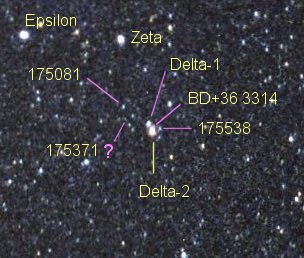
 |
The Delta-1 Lyrae Cluster. While appearing to be a naked-eye double, Delta-1 and Delta-2 Lyrae have no physical relationship. Delta-1 does, however, appear to be at the heart of a small cluster whose stars are indicated by the purple lines. The numbers are from the Henry Draper (HD) Catalogue with the exception of the one from the Bonner Durchmusterung. One of the indicated stars has questionable membership. Another dozen or so fainter stars are involved. Vega is off the top of the picture. Epsilon Lyrae, a naked-eye double, is not quite resolved, resulting in an elongated appearance. Zeta Lyrae is a complex system as well. |